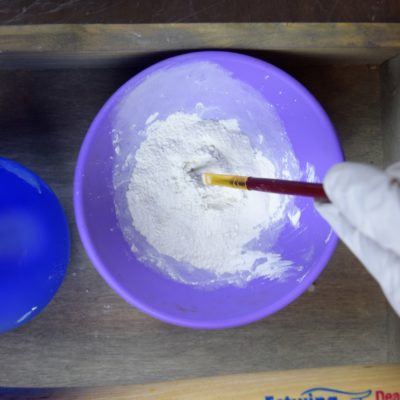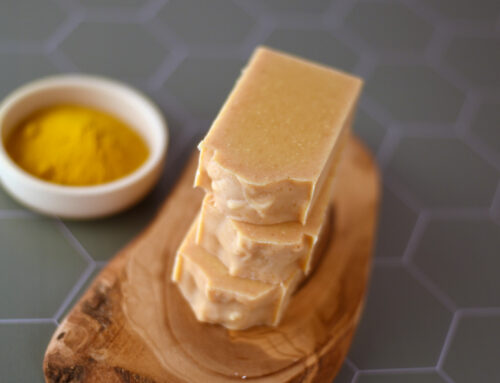Stamping is an easy way to bring a new design element to handcrafted soaps. You’ve probably seen soaps with custom logo stamps, but that’s not the only way to utilize stamped designs in handcrafted soaps. If swirling just isn’t your thing, make a solid colored soap and stamp it as an embellishment – here are just a couple of examples for starters:
There are several types of stamps available: rubber (mostly used for paper and paper crafting), acrylic, resin, wood, and metal. Each one is different, but they can all be used on soap, with a caution on using metal: some metals react with soap, and it can be hard to find out exactly what metals are used in alloys (mixed metals) – so test any metal stamps first to make sure it doesn’t cause your soaps to change colors or corrode the metal part of the stamp.
Rubber stamps: this type can be found in craft stores and online shops everywhere. The actual “stamp” part is made of a rubbery, flexible material, which isn’t rigid enough or thick enough to make a very deep impression on soap, if at all. (If the soap is really soft, you risk squishing the soap when applying pressure to stamp it, so I wouldn’t advise trying to stamp soap when it’s that soft.) However, you can make some pretty cool designs with a rubber stamp dusted with mica. Just sprinkle a little bit of mica onto a clean, flat surface (a paper plate works nicely), tap the stamp’s design part in the mica a few times to ensure good coverage, and then apply the stamp to the soap. This is the easiest way to stamp soap and a good way to start, since rubber stamps can be bought locally or online and come in a wide array of designs. The above photos with stamps of a fox and a hedgehog were made with rubber stamps and gold and silver mica.
Acrylic stamps: this type of stamp is usually a custom-made stamp, although a few sellers have pre-made designs specifically made for soap. These stamps do actually make an impression into the soap, as the depth of the stamp design is about 1/8” deep, as a rubber stamp is usually 1/16” deep. Acrylic stamps can be made with or without a handle, as some people like to use a mallet to strike the back of the stamp to make a quick and forceful stamp. It takes quite a bit of force to get an impression on soap, which can’t be too soft at the time of stamping.
Resin stamps: many of these are now made with 3D printers, and the type of resin needs to be hard enough to hold up to the job of cutting through a partially hardened soap. One advantage that resin stamps have over acrylic ones is that they can have a variety of cutting depths in the same stamp, which gives that “3D effect” of realism that other “2D” stamps cannot provide. The resin material is cheaper than acrylic and there is less labor used compared to making acrylic stamps, and 3D printers are becoming more and more common, so the price and availability of resin stamps are making them a very attractive option.
Wood stamps: over time, wood will break down with repeated contact with freshly made soap. Most wood stamps are fairly expensive and they also have a porous surface, which is likely to stick to soap. This type of stamp usually doesn’t work very well on soap.
Stamping Tips
Next, what is the best way to stamp soap? There are two other major factors to consider: Time & Technique.
Time
The best time to stamp depends on how hard the soap is: too soft, and you’ll smash or squish your soap. Too hard, and you won’t be able to get much of an impression.
Therefore, much of it depends on your soap recipe (full water or water discount, ratio of hard oils to soft oils) – if you have to leave your soap in the mold for a couple of days or more, that’s an indication that you’ll need to wait a few more days to stamp it. If you can unmold and cut your soaps within hours of pouring, like I do, you should be able to stamp soon after cutting. I discount water AND oven process, so my soaps come out of the mold as soon as they are cooled off to room temperature. I can usually cut them at the same time.
After they are cut, I let them sit for about 8 to 12 hours, enough time for the cut surface to harden up a bit. To check soap to see if it’s hard enough to stamp, give it a little “squeeze” between your fingers and thumb. If it feels squishy, let it sit for another 12 hours or so. Determining if your soap is ready to stamp will probably take some experimenting on your part, so be prepared to squish some soap at first. You can practice on end pieces and less-than-perfect cuts, too. The “Just Right” window of time is probably bigger than you think it is. Even though I stamp my soaps within hours of cutting, I can still stamp them successfully a couple of days later, too.
Technique
Stamping technique also has some variations, and experimenting with a few may be needed to find the right one for your soap. I like to use a rubber mallet because my hands aren’t that strong, and I strike the back of the stamp several times, moving it around, to strike in different areas. But you can just apply steady, even pressure with your hands, pressing the stamp into the soap. Some bath bomb presses can also stamp soap, too! (Check with the manufacturer for more details.)
If your soap tends to stick a little bit to the stamp, you can either wait a little longer to stamp, or use a piece of plastic wrap (like Saran wrap) between the soap and the stamp. Some like to spray the stamp with alcohol right before stamping, too. But most of the success or failure of stamping is more about timing than technique.
Just for fun, here’s a little photo tutorial of how I stamped some soaps recently, using an acrylic stamp that I had custom-made for me. The design didn’t have quite enough “pop” with just the stamp alone, so I decided to enhance it with an accent color, after stamping. Here’s the technique I used:
Below is a round soap made in a PVC mold, with the inside of the mold sprinkled with paprika for additional color. The soap is colored with an infusion of paprika, and poured into the mold with a funnel so it doesn’t displace the paprika powder.
Centering the stamp over the soap, I used a rubber mallet and whacked the soap with a fair amount of force (much more than a tap) about 6-7 times.
Since the lines on this stamp are thin, I pressed the stamp into the soap with my hands, going around all the edges, and squeezing it together – I could see the stamp sinking into the soap.
Spray the stamped area with 91% alcohol; I noticed that when I did this, the little “crumbs” of displaced soap seemed to disappear, so even if you’re not planning to brush an accent color on, this helps to dissolve those pesky “crumbs” and a final spray gives the soap a nice little sheen.
This is a mixture of white kaolin clay with a bit of zinc dioxide. I applied the dry powder to the surface of the stamped soap with a small paintbrush.
Load the paintbrush with dry powder and begin to paint over the wet surface of the soap; the powder dissolves easily with the alcohol. Work out any small lumps by smoothing it with the brush, and you’ll see that even the tiniest lumps will dissolve quickly. Keep loading the brush as needed to paint on an even layer of powder.
While the surface is still wet, quickly wipe off the excess clay with a dry paper towel (a small sponge might work as well.) Keep wiping until all that’s left is the clay in the stamp impression.
Set the soap aside to dry for 10-15 minutes; lightly spray with alcohol one more time to give the soap a little shine (optional.) This helps to clear up any dull film left behind by the “paint.” (Note: if you spray too soon, before it’s completely dry, the fine lines will disappear. However, you can go back and paint them again or do any touch-ups, as needed.)
These pumpkin stamped soaps have cocoa powder painted on them, using the same technique. I love the rich, dark brown color that cocoa powder gives these soaps.
Two or more colors is possible, too: I painted this tree stamp with French green clay for the leaves and cocoa powder was used for painting the trunk and branches.
Using stamps as a design element is an easy way to make handcrafted soaps more interesting and colorful. If you’ve been feeling a little “swirl challenged” or if you’re wanting to try something different, get some stamps and let your creativity flow.
With 10 years of making soap under her belt, Kathy White is owner and soap alchemist at Karis Praxis, a handcrafted soap business. She is a member and certified Advanced Level Soapmaker with the Handcrafted Soap & Cosmetics Guild (HSCG) and teaches soapmaking classes in the greater Houston and Galveston, Texas, area.























Cute, but a lot of work. I usually dab my stamp in a plate of colorful mica or bamboo carcoal and stamp the bar. Easy peasy.